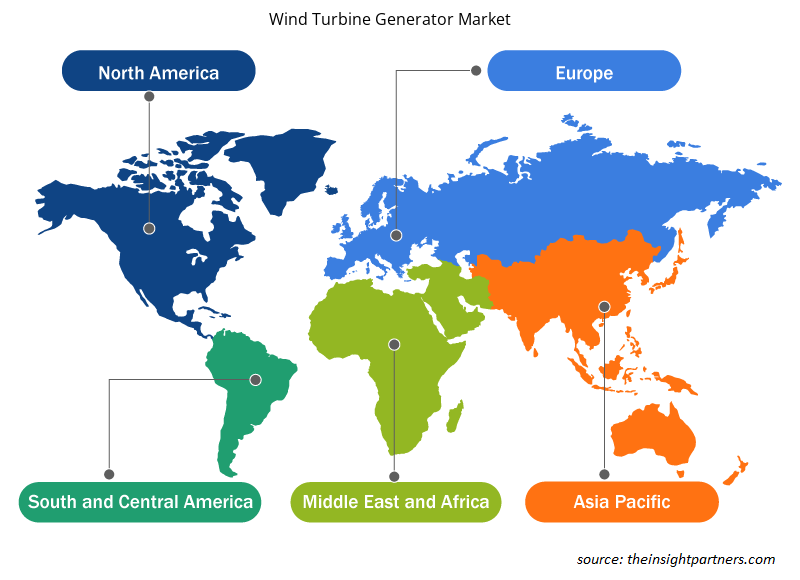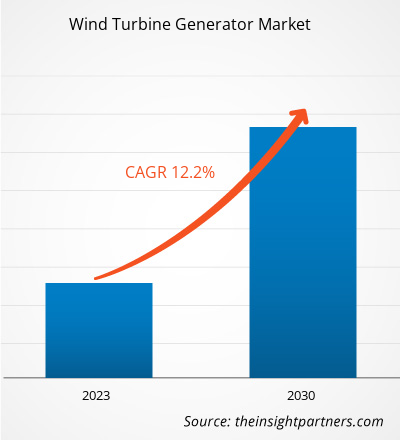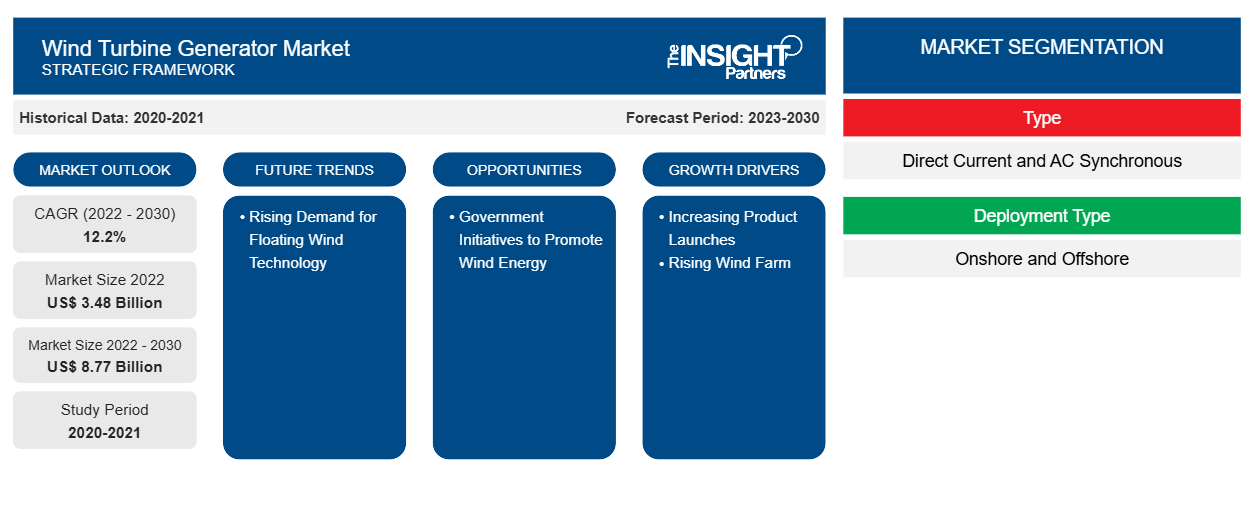[Rapporto di ricerca] Il mercato dei generatori di turbine eoliche è stato valutato a 3.483,84 milioni di dollari nel 2022 e si prevede che raggiungerà gli 8.772,57 milioni di dollari entro il 2030; si prevede che crescerà a un CAGR del 12,2% nel periodo 2022-2030.CAGR of 12.2% during 2022–2030.
Prospettiva dell'analista:
Il mercato dei generatori di turbine eoliche del Nord America è suddiviso in sottosegmenti negli Stati Uniti, in Canada e in Messico. Grazie alle severe normative governative, all'aumento degli investimenti nei progetti di energia eolica, alle politiche favorevoli e alla riduzione dei costi dell'energia eolica , si prevede che l'industria eolica in tutta la regione registrerà una crescita notevole. Con la crescente consapevolezza dei consumatori sui cambiamenti climatici e sul ruolo delle energie rinnovabili, si prevede che la domanda di turbine eoliche aumenterà in Nord America. Nel 2022, solo gli Stati Uniti (Texas) hanno installato turbine eoliche terrestri per un valore di 4.028 MW di potenza. Inoltre, nel 2022, gli altri stati degli Stati Uniti, come Nebraska e Oklahoma, hanno aggiunto una capacità di energia eolica di 600 MW ciascuno. Tutte queste iniziative governative stanno guidando la crescita della quota di mercato dei generatori di turbine eoliche negli Stati Uniti.
Il governo canadese sta investendo nelle energie rinnovabili e sta lavorando con partner indigeni per realizzare grandi progetti. Ad esempio, a maggio 2022, il Ministro delle risorse naturali ha annunciato un investimento di circa 50 milioni di dollari USA per la partnership Burchill Wind Limited tra Wolumseket e Natural Forces Development per implementare tecnologie di energia rinnovabile e modernizzazione della rete. A marzo 2022, il Canada ha annunciato i suoi piani per investire 7,2 miliardi di dollari USA in progetti eolici e solari per soddisfare gli obiettivi di riduzione delle emissioni di carbonio entro il 2030. A novembre 2021, Siemens Gamesa Renewable Energy ha annunciato di aver firmato un accordo con Renewable Energy Systems (RES) in Canada per la fornitura di turbine eoliche per il progetto eolico Hilda da 100 MW in Alberta. Questo accordo aiuterà il paese a raggiungere il suo obiettivo del 30% di generazione di energia rinnovabile entro il 2030. In base a questo accordo, Siemens Gamesa fornirà 20 turbine SG 5.0-145, fornendo energia pulita e conveniente per circa 50.000 case. Inoltre, secondo la Canadian Renewable Energy Association (CanREA), nel 2022 il Canada ha installato un totale di 1,8 GW di capacità di energia eolica e solare. Pertanto, tali prospettive di investimento nell'erezione di progetti di energia eolica e l'aumento dell'adozione di energia pulita stanno alimentando la quota di mercato dei generatori di turbine eoliche del Nord America. Vari attori del mercato dei generatori di turbine eoliche come TPI Composites Inc., Marmen Inc., Valmont Industries Inc. e The Timken Co. stanno sviluppando componenti innovativi e più efficienti per soddisfare questa crescente domanda.
Il governo del Messico ha investito una cifra significativa nella costruzione di turbine eoliche nel paese. Secondo l'Asociación Mexicana de Energía Eólica (AMDEE), è stato pianificato un investimento di circa 1,3 miliardi di $ USA per sviluppare il settore eolico messicano nel 2020. Pertanto, questo investimento ha fatto sì che il paese entrasse tra i primi 3 produttori di energia eolica più attraenti dell'America Latina. Questo fondo stanziato sarà investito in 11 progetti di energia eolica a Coahuila, Yucatan e Tamaulipas.Asociación Mexicana de Energía Eólica (AMDEE), an investment of ~US$ 1.3 billion was planned to develop the Mexican wind energy sector in 2020. Thus, this investment made the country enter the top 3 most attractive wind energy producers in Latin America. This allocated fund will be invested in 11 wind energy projects in Coahuila, Yucatan, and Tamaulipas.
Pertanto, tutti i fattori sopra menzionati stanno alimentando la crescita del mercato dei generatori eolici nel Nord America.
Personalizza questo report in base alle tue esigenze
Riceverai la personalizzazione gratuita di qualsiasi report, comprese parti di questo report, o analisi a livello nazionale, pacchetto dati Excel, oltre a usufruire di grandi offerte e sconti per start-up e università
-
Scopri le principali tendenze di mercato in questo rapporto.Questo campione GRATUITO includerà analisi di dati che spaziano dalle tendenze di mercato alle stime e alle previsioni.
Panoramica del mercato:
I generatori convertono l'energia meccanica generata dalle pale del rotore in energia elettrica tramite campi magnetici. Nella maggior parte dei casi, i generatori utilizzano corrente alternata per funzionare a una velocità costante che consente loro di generare potenza CA a 60 Hz di livello di utilità. Diversi tipi di generatori, tra cui generatori a induzione (con RPM fisso e RPM variabile), generatori a induzione a doppia alimentazione (RPM variabile) e generatori a trasmissione diretta a magnete permanente, sono utilizzati nelle turbine eoliche. Hanno diverse caratteristiche e capacità operative che vengono utilizzate in base ai requisiti di installazione della turbina eolica e alla generazione di energia.
La crescente iniziativa governativa per l'adozione dell'energia eolica per la generazione di elettricità sta creando opportunità redditizie per il mercato dei generatori di turbine eoliche. Si prevede che la crescente domanda di tecnologia eolica galleggiante per turbine eoliche offshore favorirà la crescita del mercato dei generatori di turbine eoliche durante il periodo di previsione. La tecnologia aiuterà nello sviluppo di turbine eoliche offshore dove l'acqua è molto profonda.
Fattore trainante del mercato:
L'aumento dei lanci di prodotti sta guidando la crescita del mercato dei generatori di turbine eoliche
Secondo il Global Wind Energy Council (GWEC), nel 2022 è stata installata una capacità eolica totale di 906 GW a livello globale, di cui il 93% onshore e il 7% offshore. Si prevede che i mercati dell'energia eolica quadruplicheranno nei prossimi 20 anni, aumentando ulteriormente la domanda di componenti avanzati per turbine eoliche. La crescente domanda di energia eolica richiederà componenti avanzati per turbine come pale del rotore, navicella, riduttore, generatore, torre e sistemi di passo. Ciò ha costretto gli operatori del mercato ad aumentare i propri investimenti nello sviluppo di prodotti nuovi e innovativi. Vari produttori di generatori di turbine eoliche stanno lavorando all'implementazione di prodotti avanzati per soddisfare le crescenti esigenze dei clienti. Ad esempio, a settembre 2023, Adani New Industries Ltd ha annunciato che avrebbe prodotto una serie di generatori di turbine eoliche da 5,2 MW per il mercato internazionale dei generatori di turbine eoliche.
Tali progressi nei componenti delle turbine eoliche, supportati da elevati investimenti da parte dei produttori globali e da politiche governative per il controllo del clima per migliorare il loro portafoglio prodotti, stanno alimentando la crescita del mercato dei generatori di turbine eoliche. Inoltre, la crescente domanda di componenti riciclabili per proteggere l'ambiente sta spingendo i produttori a sviluppare più componenti riciclabili. Inoltre, i produttori stanno ideando componenti più efficienti, che aiuteranno a produrre più elettricità dalle turbine eoliche riducendo i tempi di fermo delle turbine. Pertanto, la crescente innovazione di prodotto in base alle mutevoli esigenze dei clienti sta guidando la crescita del mercato dei generatori di turbine eoliche.
Analisi segmentale:
In base al tipo di generatore, il mercato dei generatori di turbine eoliche è diviso in corrente continua e sincroni AC. Nel 2022, il segmento sincroni AC ha acquisito una quota maggiore del mercato globale dei generatori di turbine eoliche grazie alla sua compatibilità con la rete e all'efficienza operativa. Inoltre, nel caso di parchi eolici offshore, i generatori AC sono particolarmente vantaggiosi. Sono adatti per la trasmissione di energia a lunga distanza da installazioni offshore alla terraferma, poiché l'energia AC può essere trasportata in modo efficiente su lunghe distanze tramite cavi sottomarini. Si prevede che i crescenti investimenti offshore stimoleranno la domanda di generatori sincroni AC nel mercato dei generatori di turbine eoliche. Ad esempio, nel 2023, Octopus del Regno Unito ha annunciato i suoi piani per investire 20 miliardi di dollari in parchi eolici offshore. Si prevede che tali iniziative stimoleranno la domanda di generatori sincroni AC.
Analisi regionale:
Il governo italiano sta investendo una notevole quantità di capitale nell'integrazione delle energie rinnovabili, incrementando ulteriormente la quota di mercato dei generatori eolici del paese. Ad esempio, a giugno 2022, ERG ha annunciato di aver piazzato un ordine da 101 MW per il parco eolico Mineo Militello Vizzini in Sicilia. Questo progetto si aggiunge agli oltre 5,4 GW di turbine eoliche installate o in costruzione da Vestas in Italia, che rappresentano una quota di mercato di oltre il 40%. Inoltre, a luglio 2021, Eni ha annunciato di aver firmato un accordo per acquisire il 100% di un portafoglio di 13 parchi eolici onshore in Italia, con una capacità totale di 315 MW, da Glennmont Partners ("Glennmont") e PGGM Infrastructure Fund ("PGGM"). Il governo italiano sta anche lavorando a incentivi per incrementare lo sviluppo di impianti eolici offshore. Inoltre, il governo si è prefissato l'obiettivo di soddisfare il 65% della domanda di elettricità del Paese tramite fonti rinnovabili, un altro fattore importante che probabilmente creerà nuove opportunità per i venditori sul mercato dei generatori eolici durante il periodo di previsione.
Approfondimenti regionali sul mercato dei generatori di turbine eoliche
Le tendenze regionali e i fattori che influenzano il mercato dei generatori di turbine eoliche durante il periodo di previsione sono stati ampiamente spiegati dagli analisti di Insight Partners. Questa sezione discute anche i segmenti e la geografia del mercato dei generatori di turbine eoliche in Nord America, Europa, Asia Pacifico, Medio Oriente e Africa e America meridionale e centrale.

- Ottieni i dati specifici regionali per il mercato dei generatori di turbine eoliche
Ambito del rapporto di mercato sui generatori di turbine eoliche
| Attributo del report | Dettagli |
|---|---|
| Dimensioni del mercato nel 2022 | 3,48 miliardi di dollari USA |
| Dimensioni del mercato entro il 2030 | 8,77 miliardi di dollari USA |
| CAGR globale (2022-2030) | 12,2% |
| Dati storici | 2020-2021 |
| Periodo di previsione | 2023-2030 |
| Segmenti coperti |
Per tipo
|
| Regioni e Paesi coperti |
America del Nord
|
| Leader di mercato e profili aziendali chiave |
|
Densità dei player del mercato dei generatori di turbine eoliche: comprendere il suo impatto sulle dinamiche aziendali
Il mercato dei generatori di turbine eoliche sta crescendo rapidamente, spinto dalla crescente domanda degli utenti finali dovuta a fattori quali l'evoluzione delle preferenze dei consumatori, i progressi tecnologici e una maggiore consapevolezza dei vantaggi del prodotto. Con l'aumento della domanda, le aziende stanno ampliando le loro offerte, innovando per soddisfare le esigenze dei consumatori e capitalizzando sulle tendenze emergenti, il che alimenta ulteriormente la crescita del mercato.
La densità degli operatori di mercato si riferisce alla distribuzione di aziende o società che operano in un particolare mercato o settore. Indica quanti concorrenti (operatori di mercato) sono presenti in un dato spazio di mercato in relazione alle sue dimensioni o al valore di mercato totale.
Le principali aziende che operano nel mercato dei generatori di turbine eoliche sono:
- XINJIANG GOLDWIND SCIENZA E TECNOLOGIA CO LTD
- Sistemi eolici Vestas AS
- Elettrico generale,
- Società per azioni Zhejiang Windey Co., Ltd.
- Suzlon Energia Limitata
Disclaimer : le aziende elencate sopra non sono classificate secondo un ordine particolare.

- Ottieni una panoramica dei principali attori del mercato dei generatori di turbine eoliche
Analisi dei giocatori chiave:
Siemens Gamesa Renewable Energy SA; ENVISION Group; Mingyang Smart Energy; Nordex SE; Xinjiang Goldwind Science & Technology Co., Ltd.; Vestas Wind Systems AS; General Electric; Zhejiang Windey Co., Ltd.; Suzlon Energy Limited; Enercon GmbH; e Nordex Group sono tra i principali attori del mercato dei generatori eolici.
Sviluppi recenti:
Le strategie inorganiche e organiche come fusioni e acquisizioni sono ampiamente adottate dalle aziende nel mercato dei generatori di turbine eoliche. Di seguito sono elencati alcuni recenti sviluppi dei principali attori del mercato dei generatori di turbine eoliche:
|
Data
|
Notizia
|
Regione
|
|
Ottobre-2023 |
Mingyang Smart Energy ha annunciato i piani per una nuova turbina eolica offshore che, con i suoi 22 MW, sarà la più grande turbina eolica offshore al mondo. Secondo l'azienda, la MySE 22MW resistente ai tifoni è adatta sia per applicazioni a fondo fisso che galleggianti. La turbina sarà costruita tra il 2024 e il 2025, secondo l'azienda. |
Asia-Pacifico |
- Analisi storica (2 anni), anno base, previsione (7 anni) con CAGR
- Analisi PEST e SWOT
- Valore/volume delle dimensioni del mercato - Globale, Regionale, Nazionale
- Industria e panorama competitivo
- Set di dati Excel
Report recenti
Rapporti correlati
Testimonianze
Motivo dell'acquisto
- Processo decisionale informato
- Comprensione delle dinamiche di mercato
- Analisi competitiva
- Analisi dei clienti
- Previsioni di mercato
- Mitigazione del rischio
- Pianificazione strategica
- Giustificazione degli investimenti
- Identificazione dei mercati emergenti
- Miglioramento delle strategie di marketing
- Aumento dell'efficienza operativa
- Allineamento alle tendenze normative























 Ottieni un campione gratuito per - Mercato dei generatori di turbine eoliche
Ottieni un campione gratuito per - Mercato dei generatori di turbine eoliche